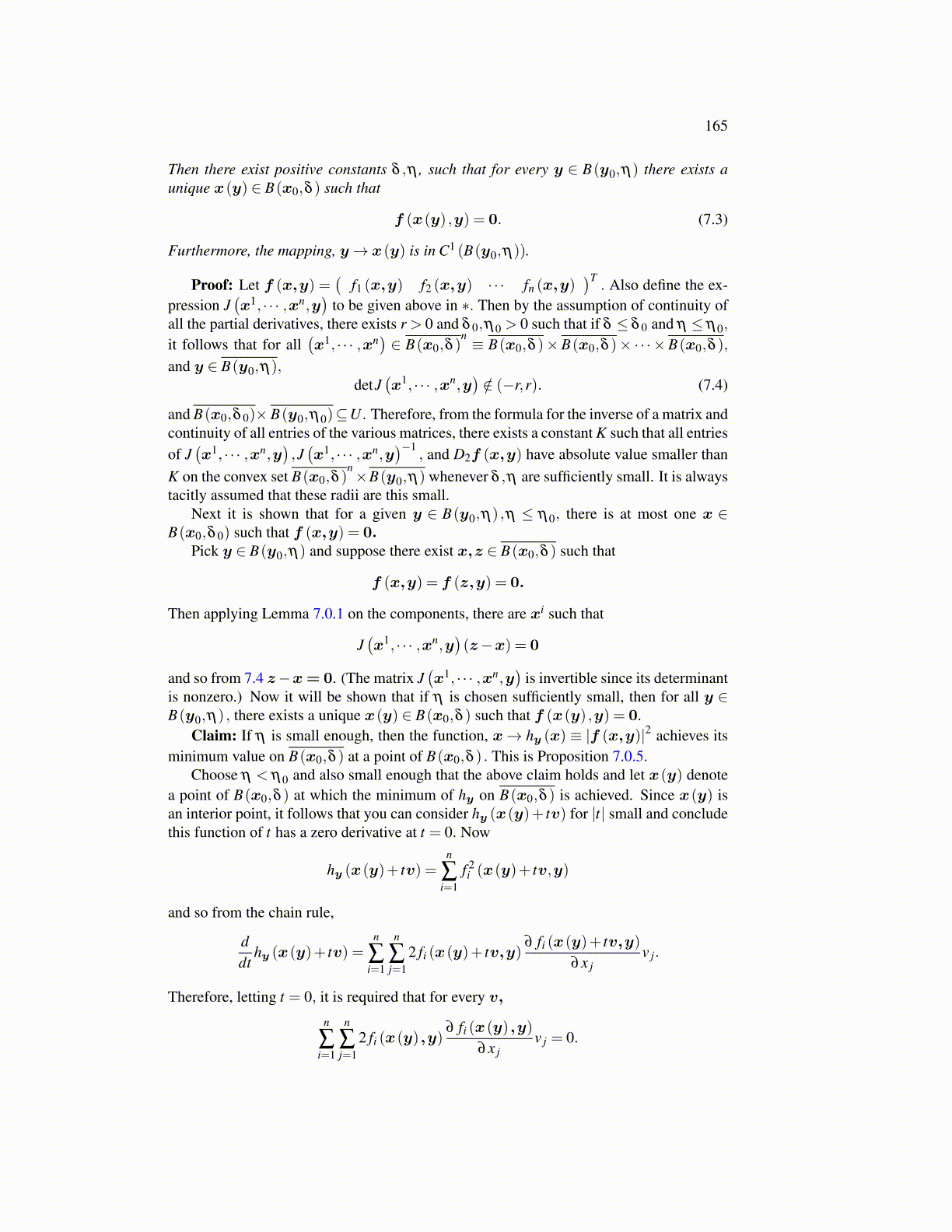
165
Then there exist positive constants δ ,η , such that for every y ∈ B(y0,η) there exists aunique x(y) ∈ B(x0,δ ) such that
f (x(y) ,y) = 0. (7.3)
Furthermore, the mapping, y→ x(y) is in C1 (B(y0,η)).
Proof: Let f (x,y) =(
f1 (x,y) f2 (x,y) · · · fn (x,y))T
. Also define the ex-pression J
(x1, · · · ,xn,y
)to be given above in ∗. Then by the assumption of continuity of
all the partial derivatives, there exists r > 0 and δ 0,η0 > 0 such that if δ ≤ δ 0 and η ≤ η0,
it follows that for all(x1, · · · ,xn
)∈ B(x0,δ )
n ≡ B(x0,δ )×B(x0,δ )× ·· · ×B(x0,δ ),
and y ∈ B(y0,η),detJ
(x1, · · · ,xn,y
)/∈ (−r,r). (7.4)
and B(x0,δ 0)× B(y0,η0)⊆U . Therefore, from the formula for the inverse of a matrix andcontinuity of all entries of the various matrices, there exists a constant K such that all entriesof J
(x1, · · · ,xn,y
),J(x1, · · · ,xn,y
)−1, and D2f (x,y) have absolute value smaller than
K on the convex set B(x0,δ )n×B(y0,η) whenever δ ,η are sufficiently small. It is always
tacitly assumed that these radii are this small.Next it is shown that for a given y ∈ B(y0,η) ,η ≤ η0, there is at most one x ∈
B(x0,δ 0) such that f (x,y) = 0.Pick y ∈ B(y0,η) and suppose there exist x,z ∈ B(x0,δ ) such that
f (x,y) = f (z,y) = 0.
Then applying Lemma 7.0.1 on the components, there are xi such that
J(x1, · · · ,xn,y
)(z−x) = 0
and so from 7.4 z−x= 0. (The matrix J(x1, · · · ,xn,y
)is invertible since its determinant
is nonzero.) Now it will be shown that if η is chosen sufficiently small, then for all y ∈B(y0,η) , there exists a unique x(y) ∈ B(x0,δ ) such that f (x(y) ,y) = 0.
Claim: If η is small enough, then the function, x→ hy (x) ≡ |f (x,y)|2 achieves itsminimum value on B(x0,δ ) at a point of B(x0,δ ) . This is Proposition 7.0.5.
Choose η < η0 and also small enough that the above claim holds and let x(y) denotea point of B(x0,δ ) at which the minimum of hy on B(x0,δ ) is achieved. Since x(y) isan interior point, it follows that you can consider hy (x(y)+ tv) for |t| small and concludethis function of t has a zero derivative at t = 0. Now
hy (x(y)+ tv) =n
∑i=1
f 2i (x(y)+ tv,y)
and so from the chain rule,
ddt
hy (x(y)+ tv) =n
∑i=1
n
∑j=1
2 fi (x(y)+ tv,y)∂ fi (x(y)+ tv,y)
∂x jv j.
Therefore, letting t = 0, it is required that for every v,
n
∑i=1
n
∑j=1
2 fi (x(y) ,y)∂ fi (x(y) ,y)
∂x jv j = 0.